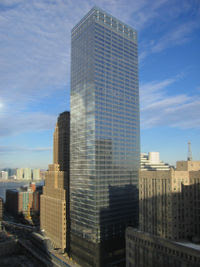This just in
The demolition industry will no longer induce symmetrical collapse with symmetrically placed charges.
Sept. 11, 2001 illustrated conclusively that a bomb placed near the top of the building so that it creates the most damage in a perimeter area (in lieu of a 767), combined with dowsing and igniting some office furniture is a completely effective means of demolition.
This is not without controversy. There is a faction within the community that argues that September 11th actually illustrated a better and more cost-effective means of demolition. They point to World Trade Center Building 7, and conclude that fires on several random floors using whatever is already available within the building for fuel, plus, of course, a sizable gash in one corner of the building and a few other minor and random attacks upon the building's exterior is sufficient to cause the free-fall, global, symmetrical destruction for which the industry is justly famous.
Part of the controversy stems from the fact that many of the demolition professionals were not aware that the terrorist incident had caused not two, but three buildings to fall into their footprints. They were informed by the breakaway faction that yes, not only was WTC 7 a victim of the vicious assault, it had also been completely rebuilt, but since the media has treated the building's global, symmetrical and free-fall collapse as if it did not happen, it has also treated the achievement of standing up to the attack by rebuilding a 52-story skyscraper as if it hasn't happened, when, indeed, the building opened its doors for business in 2006, a proud symbol of American resolve.

The original WTC 7 was replaced with the new 7 World Trade Center, which opened in 2006. Both buildings were developed by Larry Silverstein who holds a ground lease for the site from the Port Authority of New York and New Jersey. -- Wikipedia
The demolition industry will no longer induce symmetrical collapse with symmetrically placed charges.
Sept. 11, 2001 illustrated conclusively that a bomb placed near the top of the building so that it creates the most damage in a perimeter area (in lieu of a 767), combined with dowsing and igniting some office furniture is a completely effective means of demolition.
This is not without controversy. There is a faction within the community that argues that September 11th actually illustrated a better and more cost-effective means of demolition. They point to World Trade Center Building 7, and conclude that fires on several random floors using whatever is already available within the building for fuel, plus, of course, a sizable gash in one corner of the building and a few other minor and random attacks upon the building's exterior is sufficient to cause the free-fall, global, symmetrical destruction for which the industry is justly famous.
Part of the controversy stems from the fact that many of the demolition professionals were not aware that the terrorist incident had caused not two, but three buildings to fall into their footprints. They were informed by the breakaway faction that yes, not only was WTC 7 a victim of the vicious assault, it had also been completely rebuilt, but since the media has treated the building's global, symmetrical and free-fall collapse as if it did not happen, it has also treated the achievement of standing up to the attack by rebuilding a 52-story skyscraper as if it hasn't happened, when, indeed, the building opened its doors for business in 2006, a proud symbol of American resolve.

The original WTC 7 was replaced with the new 7 World Trade Center, which opened in 2006. Both buildings were developed by Larry Silverstein who holds a ground lease for the site from the Port Authority of New York and New Jersey. -- Wikipedia

